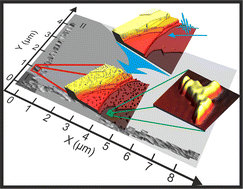Locally varying formation of nanoclusters across a low-intensity ultra-short laser spot†
Abstract
Ultra-short laser illumination is an intriguing tool for engineering material by light. It is usually employed at or above the ablation threshold. Practical applications profit from tailoring surface properties, for instance, by structural changes to the surface layer of an irradiated target. A target-orientated restructuring of surfaces on the nanoscale is much less explored. In particular, an intrinsic intensity variation across a laser spot has not yet been considered or employed. We image the unexpected nanoscale clusters formed on the Cu(111) surface upon illumination of a Cu sample far below its ablation threshold by femtosecond laser light, employing a specifically-developed multi-scale approach. We unravel that these clusters vary significantly in size and shape across the micrometer-scale 400 nm 50 fs laser spot (repetition rate: 250 kHz). There are three qualitatively different regions separated by sharp changes. The observations highlight the importance of local fluence for specific types of nanoclusters. Ultra-short laser illumination represents a non-trivial interplay between photo-thermal and electron-induced mechanisms, transport of heat and electrons, and material properties, which we discuss for identifying the underlying principles. Our study demonstrates that a multitude of as yet unconsidered processes are involved in the tailoring of nanoscale materials by ultra-short laser light.

- This article is part of the themed collection: Celebrating International Women’s Day: Women in Nanoscience


 Please wait while we load your content...
Please wait while we load your content...